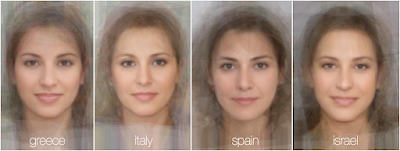In attractiveness studies, averageness is one of the characteristics of physical beauty in which the average phenotype, i.e. outward appearance, of the individual theoretically characterizes averaged genotypes, thus indicating health and fertility. The majority of averageness studies and theories have to do with photographic overlay studies, in which images are morphed together. Other factors involved in measuring attractiveness are symmetry, youthfulness and similarity (like-attracts-like).
In 1883, Francis Galton, cousin of Charles Darwin, devised a technique called composite photography, described in detail in Inquiries in Human Faculty and its Development, which he believed could be used to identify 'types' by appearance, which he hoped would aid medical diagnosis, and even criminology through the identification of typical criminal faces. In short, he wondered if certain groups of people had certain facial characteristics. To find this answer, he created photographic composite images of the faces of vegetarians and criminals to see if there was a typical facial appearance for each. Galton overlaid multiple images of faces onto a single photographic plate so that each individual face contributed roughly equally to a final composite face. While the resultant “averaged” faces did little to allow the a priori identification of either criminals or vegetarians, Galton observed that the composite image was more attractive than the component faces. Similar observations were made in 1886 by Stoddard, who created composite faces of members of the National Academy of Sciences and graduating seniors of Smith College. This phenomenon is now known as "averageness-effect", that is highly physically attractive tend to be indicative of the average traits of the population.
In 1990, one of the first computer-based photographic attractiveness rating studies was conducted. During this year psychologists Langlois and Roggman wanted to systematically examine whether mathematical averageness is linked with facial attractiveness. To test this, they selected photographs of 192 male and female Caucasian faces; each of which was computer scanned and digitized. They then made computer-processed composites of each image, as 2-, 4-, 8-, 16-, and 32-face composites, averaged by pixel. These faces, as well as the component faces, were rated for attractiveness by 300 judges on a 5-point Likert scale (1 = very unattractive, 5 = very attractive). The results showed that the 32-composite face was the most visually attractive of all the faces.
Work on isolated populations suggest that preferences for averageness appear to be universal. In addition, while isolated people prefer average faces from their own race, they do not show any preference for average faces of other races to which they are not exposed. This makes sense since they should have no knowledge of what an average face looks like. This suggests that it is averageness alone, that is making a face attractive rather than some other artifact that results from the averaging techniques.
via: Wikipedia | Read more:
Image via:



